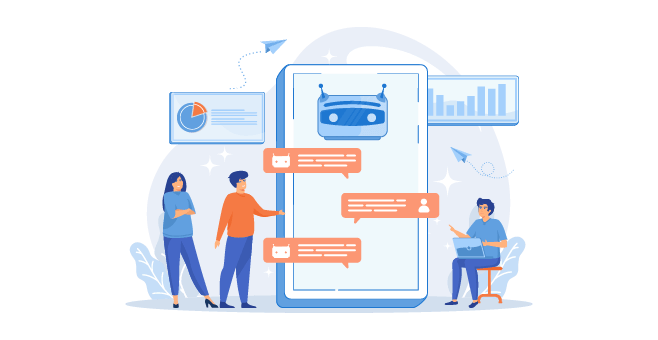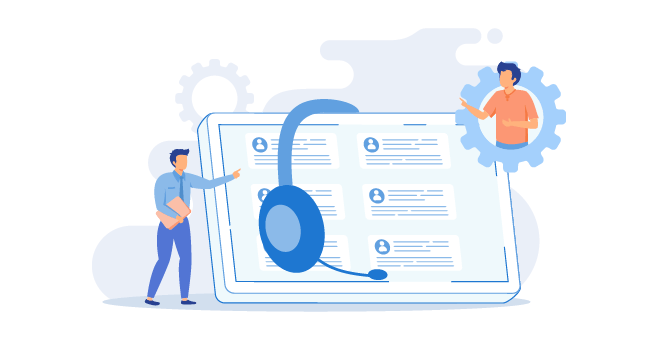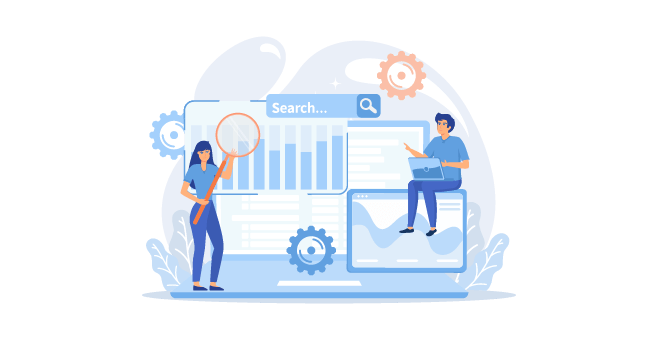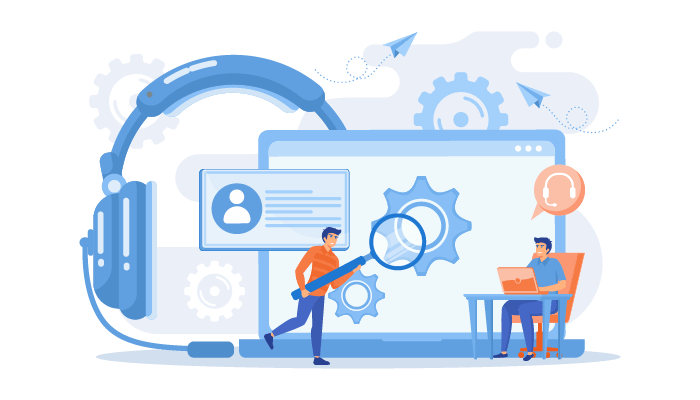Today’s customers are a demanding bunch. If they have a problem or a question, they expect immediate information and quick resolution — but keeping up with this demand can be an impossible task for your contact center’s live agents alone. That’s where self-service comes in.
Even if you provide 24/7 live support, there are many situations where a customer can’t get in contact or doesn’t have the time to wait for an agent to become available.
Customer self-service, or CSS, refers to any type of electronic or automated support that allows customers to find answers or resolve problems without having to connect with a customer service agent. Self-service lets users resolve problems without waiting for an agent’s response and lightens the load on your customer support team. Examples include FAQ sections on websites, chatbots, help center blog forums, self-service account creation, password resetting, and interactive voice technology in call centers.
Comparing Self-Service to Human Assistance
The best way to think about customer service is to divide the whole universe of possible interactions into two realms: Those that are self-serve (“Where’s my shipment?”) and those that require human assistance (“I don’t understand my bill”.) Within those realms, you can have further division into channels and strategies. For example, a self-serve interaction that may have been done over the web last year may now be available via chatbot. Human assistance may be offered over SMS instead of voice.
Such changes and improvements within each realm are common. Movements from the human realm to the self-serve realm is harder. Most interactions that lend themselves easily to self-service are already in that realm. The low-hanging fruit was picked long ago.
With this in mind, one can read “AI/chatbot” stories more critically. For example, if a company is boasting about banking-by-chatbot, ask yourself how much of that interaction was previously done over their website, and thus already in the self-serve realm? (Note that there still might be value in switching from web-based to bot-based banking: increased engagement, higher containment rate, or simply catering to certain consumers.) What’s more impressive, though, are projects that bring “net new” interactions into the self-serve realm. One such example is the sommelier-in-a-bot launched by Lidl. Hats off to the team at Aspect!
The Benefits and Pitfalls of Self-Service
Offering customers a self-service option can increase customer satisfaction and reduce your call volume – thereby reducing your operating costs. However, there are several special considerations when deciding whether to install self-service options in your call center.
TIP:
Today, 70% of customers expect self-service options.
The biggest benefits
Customers can use self-service menus or interactive voice response (IVR) to perform a variety of tasks. A properly scripted menu leads customers to the answer they need, provides them with the opportunity to navigate to a live agent, and decreases the overall call volume that reaches your call center.
Typical self-service content covers issues that are most frequently encountered by your agents. These inquiries are easy to identify and resolve when customers have access to the answers they need. Self-service diverts calls from the queue, decreasing call volume. As a result, only more complex or unusual calls make it through the system to live agents.
Common inquiries easily handled by self-service include:
- Warranty information
- Return policy questions
- Common service issues
- Product information and pricing
- Business location, and hours
DID YOU KNOW?
45% of companies offering self-service reported higher agent satisfaction. – NICE
Potential pitfalls
There are several important considerations to make when implementing a self-service option in your call center. Most importantly, you need to understand the demographics of your customers and how they interact with your business. Be sure that your self-service options are tailored to your customers wants and needs.
- Inform your customers that you have installed a self-service system and invite them to use it. They will continue to seek out live agents over self-service if they don’t know what information they can find there.
- Customers must be able to choose whether or not to use your self-service menu. Provide them with the choice to speak to an agent, and make sure that they know how to navigate back to the main menu when needed.
- Don’t put too much information in your self-service system. Customers can get lost when given too many options.
DID YOU KNOW?
Despite the clear demand for self-service, 55% of consumers find self-service portals difficult to use.
Metrics and Assessment
One of the first steps towards creating a high-quality customer self-service strategy is to dive right into analytics. It is important to track key metrics that will help determine which information is the most important to share, as well as how that information should be shared.
Most call center agents will tell you that the same questions and pain points arise time and time again from different customers. Ensuring these answers are readily available on a website FAQ section, blog post, or help forum for customers to find will help increase the efficiency of customer service agents. It will also help decrease the customer wait time and improve customer satisfaction.

Companies can also look at key search terms related to customer pain points to see which problems are arising most often. To help identify these key questions and pain points, companies should not only investigate Google searches but searches on their own websites as well.
A well-designed and accessible customer satisfaction survey about whether to install self-service and what kinds of options customers want can be extremely informative. Your call center software can help you assess the service once it has been put into place.
- Check the metrics. After implementing a self-service option, be sure to track metrics such as call abandon rates, call volume, first call resolution rates, and how many customers opt out of the IVR for live-agent support. This information can tell you whether the self-service menu is functioning properly and providing improved customer service.
- Ask for feedback. According to a report from ICMI, 44% of call centers don’t solicit customer feedback on their self-service menu, and 24% don’t know whether calls were being completed through their IVR.
Incorporating self-service menu options in your call center can decrease the number of calls that reach live agents, improve customer service, and lower your operating costs. Assess your call center’s metrics and the needs of your customers to determine if your call center should be using self-service.
The Top 5 Self-Service Tools in the Call Center
At this point, we’ve mentioned more than a few common self-serve tools. But here’s a handy list of the most popular trending technology that modern call centers are adopting.
1. Smart chatbots
Chatbots have come a long way in the last few years. In fact, 48% of contact centers have invested in AI chatbots for self-service, according to Cisco’s 2020 report. With natural language processing (NLP) in play, these smart tools can engage in basic conversation with your customers online, directing them to the right resources to solve their simple queries. What’s more, chatbots can handle hundreds of conversations at a time, so while they’re taking care of common questions, your human agents can focus on the more complex queries.
2. AI-powered agent assist
AI is the new call center sidekick for your agents. This amazing technology can automate manual, repetitive tasks for your staff, freeing up their time to support your callers. Not only that, agent assist can also listen in on customer conversations and make recommendations to the agent based on conversation history, the customer’s tone of voice, and much more.
3. Knowledge Bases and FAQs
Knowledge bases and FAQs aren’t new to the call center world, but they still hold a lot of value for customers who prefer self-service. By answering commonly asked questions and hosting them in an online database for users to look up, you put the power in their hands to find a solution to their issue. Just make sure the database is easy to use and navigate!
4. Advanced IVR software
We aren’t talking about your traditional phone menu. Those clunky and repetitive IVRs, while a staple in the contact center, have been upgraded to a much more customer-friendly experience. With conversational AI technology, advanced IVR software can create more human exchanges and direct the caller to the correct channel for their query.
5. Web Call-Backs
Formerly known as Visual IVR, Web Call-Backs lets you add a widget to your website or mobile app, allowing digital users to request and schedule a call-back from a live agent at a time that works for them. This lets callers avoid the wait to speak with support, while lowering your overall call volumes. Win-win!
Visual IVR: The Missing Link Between Your Voice and Digital Channels from Fonolo on Vimeo.
7 Call Center Best Practices for Implementing Self-Service
Once you’ve assessed the pros and cons of self-service tools for your call center, the next step is to familiarize yourself with best practices. Like most things, there are right ways and wrong ways to offer these tools to your customers, and it’s important to set call center team up for success.
1. Review your support tickets
When creating self-service content for your customers, it’s helpful to know what customers are asking about. Reviewing support tickets for customer insights is a daily practice that will provide valuable insight. Not to mention, it will help with updating your FAQ and also provide inspiration for blog posts, videos and tutorials.

There are a few ways to get this important information:
- Take notes on live calls. It’s still good practice for your live agents to make detailed notes on each customer’s call. Also, if you’re using AI-supported software, conversations can be automatically recorded and screened for trends and pain points.
- Sort inquiries into categories. Create categories for each subject or type of question clients ask. By sorting tickets into these categories, you can see topics your customers need more information about.
- Use NLP to help categorize topics. Simple searches through your support tickets can quickly show you how often a topic is discussed. Natural Language Processing (NLP) software can then work out what the customer was asking, saving a lot of time manually reviewing each ticket.
- Track support requests on competitors’ social media. Tracking support requests and queries on your competitors’ social media can also provide inspiration for self-service content.
When reviewing your support tickets, you may discover that a lot of customers are getting in touch about something you have already covered in a post or tutorial. This could be a sign that either you need to increase awareness of your self-service channels, or your self-service content was not helpful.
Include a rating system in your tutorial content so customers can tell you if a page solved their issue or not, with the option of giving more details if needed. This is a great way to identify and revise ineffective self-service pages.
2. Provide self-service on multiple channels
Offering useful self-service content across multiple channels is vital to ensuring customers can get help in any situation. For example, a user might be unable to watch a tutorial video due to their internet connection, in which case they would need a written guide to avoid needing to call you.
When explaining complex features of your service or product, it is also important to remember that people absorb information in different ways. Some are visual learners, who can easily understand videos and infographics, while others learn better from text or even interactive content.
If you don’t provide the same information in multiple formats, some clients may not be able to use your self-service content. Here are some examples of self-service channels that can help different types of users:
- Chatbots or SMS, instant messaging apps and live chat
- Blogs, tutorials and guides
- In-app tutorials and interactive learning tools on your website
3. Get users to help each other
Your more experienced users are a fantastic resource when it comes to tips, tricks and troubleshooting steps for your products. Your most enthusiastic customers already want to talk about how they are using your services and swap tips and ideas. All you need to do is provide a place for those discussions, and let your customers know where to find them.
Instant messaging groups are a great way for customers to get quick responses to their questions from other customers. The fast, open discussions that instant messaging encourages means that answering a query or helping someone fix a problem often becomes a group effort. This not only provides your user with a range of answers from different perspectives but also ensures wrong answers are usually corrected quickly.
Customer support forums may seem a little outdated in the age of social media and instant messaging, but providing these in addition to other support methods still has its advantages:
- Forum posts appear in Google search results. If a customer’s question has already been asked, they can find it easily even if they don’t know you have a forum.
- Forum threads stay available for years. In an instant messaging group, conversations move quickly, which can result in the same questions being asked again by newer clients.
- Answers tend to be more detailed, and users expect to wait longer for a response. You can also amend and update them over time as the information evolves, reducing the risk of a customer getting an incomplete or unsatisfactory answer to their query.
These methods work best with active moderation. By keeping tabs on the discussion, your agents can step in where necessary to provide extra information and show you aren’t just leaving customers to figure it out themselves.
Promoting your most active members within the group or forum not only lets them help you with this but also marks their account so other users can spot posts made by the most helpful members.
4. Make it easy to find
Creating great self-service content won’t help your customers if they can’t find it. 67% of consumers won’t spend more than 15 minutes looking for an answer online. Whether your customers are getting in touch via call or message, or simply browsing your site, make sure customers know where to find your support resources.

- Include a support section in your navigation banner, and make sure that customers land on a self-service page instead of going straight to a contact form or phone number.
- Encourage agents to send users self-service content as part of their support, and let customers know they can answer future queries by searching on your site. If you are using a social media marketing agency, make sure they also know to link your self-service content where appropriate.
- SEO matters for your self-service content as much as any other part of your site. Clients trying to solve a problem will often Google it before heading to your site, so optimizing your content to appear on the first page of search results helps them find an answer quickly and avoids unnecessary customer contact.
By making your self-service resources easier to find, you can let customers solve their issues with less frustration and reduce the workload of your live agents.
5. Seamlessly transition from self-service to live support
Self-service content should allow customers to get in touch with a live agent where needed.
Investing time and effort searching for a tutorial or troubleshooting guide only to be unable to fix the problem anyway can be a frustrating experience. If you make them fight to get through to a support agent to explain their issue, this is only going to add to their annoyance, particularly if they need to sit through a long hold time first.
Integrating live support into your self-service content can give your live agents all the information they need before they talk to a customer, resulting in a painless user experience. There are a few ways to do this:
- Using SMS and instant messaging chatbots is a great way to automate your first line of support and handle simple queries quickly. Capable chatbots can answer 80% of user queries. You should also provide a button or keyword to connect clients with customer support so that your staff can join the chat with access to the full chat history.
- Include triggers to involve live support according to the process your automated emails or chat are following. If a process or query needs the attention of a live agent, they can take over straight away without waiting for your client to request live support.
- Put a call-back button on your self-service pages. This lets customers talk to your support team quickly, and your team will know which page they made the request from. You can combine this with an optional form so customers can give you more information before hitting the call-back button.
Good self-service ensures customers can get help regardless of the situation. To make use of it, customers need to be able to easily find information in a format they can learn from.
Enable users to learn from each other, and when self-service isn’t enough, ensure a seamless transition to live support that doesn’t make customers repeat themselves.
6. Answer frequently asked questions
Once key questions have been identified, companies should make efforts to ensure that answers to these key questions are readily available to customers in an FAQ section. When possible, video or screenshot examples should be included to help customers walk through the process.
Importantly, these FAQ pages should be constantly updated to ensure that information is up to date and easy to understand. It is also crucial to ensure that content is optimized for both desktop and mobile experiences. Taking these steps will ensure that, no matter how the customer is accessing the information, they will have a positive user experience.
7. Provide options
Everybody loves choice. In order to have a successful self-service strategy, there should be as many options as possible for consumers. For example, call centers may want to incorporate interactive voice response technology, but they should also make sure that a customer service agent is easily reachable if that is the customer’s preference. Research has shown that there can be a significant return on this investment. Specifically, a study by Forrester Research and Oracle discovered that web self-service can reduce call center costs by as much as $11 per call. For a high-volume call center, this can be quite a significant amount of savings.
Self-service technology should not work to replace customer service agents. Rather, these strategies should be in place to free up agents to deal with more complex complaints, as opposed to having them answer repetitive, mundane questions that could easily be found on an FAQ section of a website. By implementing a hybrid solution, both your customers and your bottom line will certainly thank you.

Discover the Contact Center Trends That Matter in 2024
Dig into industry trends and discover the changes that matter to your business in the year ahead.
